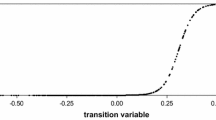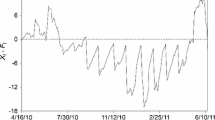Abstract
This paper examines the causal structure between daily closing price series of the Chinese stock index and futures from April 16, 2010, the launch date of the futures, to November 14, 2014, through a rolling approach that takes into account window sizes of a half, one, one and a half, and two years. Except for several subperiods associated with the half- and one-year window, the two series are tied together through cointegration and adjust equally toward the long-run relationship. Considering different forecasting lengths, the out-of-sample Granger causality test for each window generally reveals that no series gains forecastability from another. These results shed light on the evolving causal structure between the two series, which is determined to be stable. The futures market, however, has not been fully developed to serve as a price discovery source. Increasing openness of investment channels and policy incentives to attract well-informed traders may stimulate futures market development.









Similar content being viewed by others
Notes
The recursive approach that continuously adds more observations to the sample for the model estimation until the end of a time series also incorporates the idea of investigating potential time-varying relationships. However, it is difficult to differentiate whether changing test statistics are due to changes in linkages among variables or to increases in the power of tests with observations added recursively (Kutan and Zhou 2003). With the rolling approach of a given window size, the sample size for the model estimation is constant, but the sample period evolves (Rangvid and Søensen 2002) to reflect variations in relationships among variables arising from changing information embedded in the series.
Attributions of changes in price dynamics involve more market structure variables, such as investor structures and market openness, and are left for future studies.
Unless stated otherwise, “log prices” will be referred to as “prices” hereafter.
There are 242, 244, 243, 238, and 245 trading days in 2010, 2011, 2012, 2013, and 2014, respectively.
Results for half- and one-year rolling windows for which cointegration does not hold, i.e., the subperiods marked with gray bars, are not reported in subfigure (p) of Figs. 4 and 6. Imposing cointegration for these subperiods and testing the null hypothesis results in the same conclusion as that based on windows for which cointegration establishes. Numerical results are available upon request.
Results for half- and one-year rolling windows for which cointegration does not hold, i.e., the subperiods marked with gray bars, are not reported in subfigure (q) of Figs. 4 and 6. Imposing cointegration for these subperiods and testing the null hypothesis results in the same conclusion as that based on windows for which cointegration establishes. Numerical results are available upon request.
References
Amato, J.D., Swanson, N.R.: The real-time predictive content of money for output. J. Monet. Econ. 48, 3–24 (2001)
Ashley, R., Granger, C.W.J., Schmalensee, R.: Advertising and aggregate consumption: an analysis of causality. Econometrica 48, 1149–1167 (1980)
Ashley, R.A., Tsang, K.P.: Credible Granger-causality inference with modest sample lengths: a cross-sample validation approach. Econometrics 2, 72–91 (2014)
Chao, J., Corradi, V., Swanson, N.R.: Out-of-sample tests for Granger causality. Macroecon. Dyn. 5, 598–620 (2001)
Dickey, D., Fuller, W.: Likelihood ratio statistics for autoregressive time series with a unit root. Econometrica 49, 1057–1072 (1981)
Diebold, F.X., Mariano, R.S.: Comparing predictive accuracy. J. Bus Econ. Stat. 13, 253–263 (1995)
Engel, C.: The forward discount anomaly and the risk premium: a survey of recent evidence. J. Empir. Finance 3, 123–192 (1996)
Engle, R., Granger, C.W.J.: Co-integration and error correction: representation, estimation and testing. Econometrica 55, 251–276 (1987)
Granger, C.W.J.: Investigating causal relations by econometric models and cross-spectral methods. Econometrica 37, 424–438 (1969)
Harvey, D., Leybourne, S., Newbold, P.: Testing the equality of prediction mean squared errors. Int. J. Forecast. 13, 281–291 (1997)
Hou, Y., Li, S.: Price discovery in Chinese stock index futures market: new evidence based on intraday data. Asia Pac. Financ. Mark. 20, 49–70 (2013)
Johansen, S.: Statistical analysis of cointegration vectors. J. Econ. Dyn. Control 12, 231–254 (1988)
Johansen, S.: Estimation and hypothesis testing of cointegration vectors in Gaussian vector autoregressive methods. Econometrica 59, 1551–1580 (1991)
Johansen, S.: Determination of cointegration rank in the presence of a linear trend. Oxf. Bull. Econ. Stat. 54, 383–397 (1992)
Kutan, A.M., Zhou, S.: Has the link between the spot and forward exchange rates broken down? evidence from rolling cointegration tests. Open Econ. Rev. 14, 369–379 (2003)
Kwiatkowski, D., Phillips, P., Schmidt, P., Shin, Y.: Testing the null hypothesis of stationarity against the alternative of a unit root: How sure are we that economic time series have a unit root? J. Econ. 54, 159–178 (1992)
Ng, L., Wu, F.: The trading behavior of institutions and individuals in Chinese equity markets. J. Bank. Finance 31, 2695–2710 (2007)
Phillips, P., Perron, P.: Testing for a unit root in time series regression. Biometrica 75, 335–346 (1988)
Rangvid, J., Søensen, C.: Convergence in the ERM and declining numbers of common stochastic trends. J. Emerg. Mark. Finance 1, 183–213 (2002)
Rossi, B.: Advances in forecasting under instability. In: Graham, E., Allan, T. (eds.) Handbook of Economic Forecasting. Elsevier, Amsterdam (2013)
Tang, C.F., Abosedra, S.: Tourism and growth in Lebanon: new evidence from bootstrap simulation and rolling causality approaches. Empir. Econ. 50, 679–696 (2016)
Wang, Z., Yang, J., Li, Q.: Interest rate linkages in the Eurocurrency market: contemporaneous and out-of-sample Granger causality tests. J. Int. Money Finance 26, 86–103 (2007)
Yang, J., Yang, Z., Zhou, Y.: Intraday price discovery and volatility transmission in stock index and stock index futures markets: evidence from China. J. Futures Mark. 32, 99–121 (2012)
Acknowledgements
I thank an anonymous referee and Markus Schmid (editor) for their helpful comments.
Author information
Authors and Affiliations
Corresponding author
Rights and permissions
About this article
Cite this article
Xu, X. The rolling causal structure between the Chinese stock index and futures. Financ Mark Portf Manag 31, 491–509 (2017). https://doi.org/10.1007/s11408-017-0299-7
Published:
Issue Date:
DOI: https://doi.org/10.1007/s11408-017-0299-7




